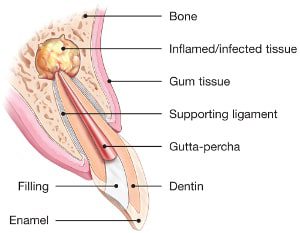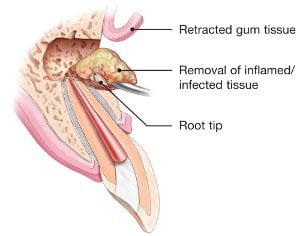Endodontic Microsurgery (Apicoectomy)
Endodontic microsurgery may be the best treatment option if a previously root canal treated tooth exhibits signs or symptoms of persistent or recurrent infection. Root canal treatment has a very high rate of success, but as with other medical or dental procedures, infection or inflammation may persist or recur despite our best efforts. Your endodontist may be able to provide insight into potential causes and how they may be corrected. Although root canal retreatment is usually the more conservative, preferred treatment option for a persistent infection, endodontic microsurgery has some advantages in certain situations. We will discuss treatment options with you to help determine which procedure is right for you. Endodontic microsurgery will not be performed at the initial consultation visit and will therefore require a second appointment for the procedure.
The most common endodontic surgery is called root-end resection or apicoectomy. After profound local anesthesia is achieved, a small incision is made near the gum-line and the gum tissue is temporarily moved in order to gain access to the inflamed or infected area. The tip of the root is removed, cleaned with an ultrasonic instrument, and a root-end filling is placed to seal the canal. Finally, a few stitches are placed to allow the gum tissue to properly heal.
A follow-up appointment is required to remove the sutures and evaluate healing. Over a period of months, the bone heals around the end of the root.
Endodontic Surgery
Learn how endodontists perform surgery to treat an abscess or infection and save your tooth.




